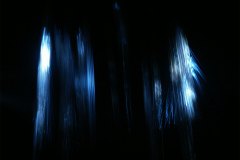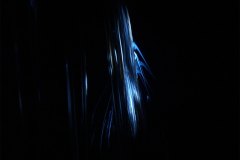Photo: Yasuhiro Chida
Kobe biennale/Hyogo,Japan
2009
Vegetable oil, Pump, LED light, Fluorescent light, Pipe, Tarpaulin, Wood
W: 2.3m×D: 12.0m×H: 2.2m (Size variable)
This work attempted to lock up light and time in a fluid material: a sculpture made of fluids whose shape is determined by their continuous flow. 1000 liters of oil cascade continuously from the ceiling like a waterfall, inside a 40 foot shipping container. Because of its viscosity, the flowing oil appears to be stationary. At the bottom, the brimming pool of oil shimmers quietly, its surface expanding like a mirror.
Nature establishes a relationship with humans just by being there. As such, it is possible to interpret and receive it in any way: we see in nature what we, ourselves, saw there. Nature is like a mirror that reflects the inner self. Things that are hard to grasp — like the stunning beauty of nature, its complexity, and the laws behind these phenomena — are transferred into the work just as they are, without attempting to impose understanding on them. Artistic creation wrought by a human hand that does not depend on it forges an intimate relationship with nature. The relationship between the author and nature, that between the author and the viewer, that between nature mediated by the artwork, and that between people who have experienced the work, all have a “loop”(*) that runs through them that differs from the act of confronting nature directly. A truly distinct sense of an individual or ethnic group — such as the Japanese sensibility of wa (harmony) — consists in what remains after superficial forms of expression and technique have been eliminated. The pallid light used in this work is one of the four colors that the Japanese have been aware of since ancient times: red, white, black, and blue. Blue is a color that connotes beauty. It is also the color of the thin atmosphere that covers the surface of the Earth as seen from space — to me, the most beautiful color of all.
*The Japanese for “loop” is wa 輪, which is a homonym for wa 和, a term that refers to harmony, and Japanese culture and attributes in general. <D.W>
流動的な物質の中に光と時間を閉じ込める。流れ落ち続ける液体によって形作られる液体の彫刻。40ft の輸送用コンテナ内、1000L のオイルが天井から滝のように流れ落ち続ける。流れるオイルはその粘性により静止して見える。底にはオイルを湛えたプールが鏡のように広がり静かに揺らぐ。
自然はただそこにあることで人と関わる。それ故にどのようにも受け取ることができ、人はそこに「自分の見たもの」を見る。それは内面を写す鏡のようである。自然の圧倒的な美しさ、複雑さ、その背後にある法則。それらの捉え難いものを捉えないまま作品へと移行させる。人の手によるが人の手によらない制作は、自然と親密な関係を結ぶ。そこには作者と自然の関わり、作者と鑑賞者の関わり、作品を介しての自然との関わり、作品を体験した人同士の関わり、自然と直に向き合う事とはまた違った「輪」が広がる。本来の個性や民族性-日本人の感性「和」-は、表面的な表現や技法を外し、突き詰めたその先に残るものである。作品に使われる青白い照明は、日本人が古くから認識していた四色「赤し」「白し」「黒し」「青し」のうちの一色で、美しさに関する色であり、また私が最も美しいと感じる、宇宙から見た地球の表面を薄く覆う大気の色である。



